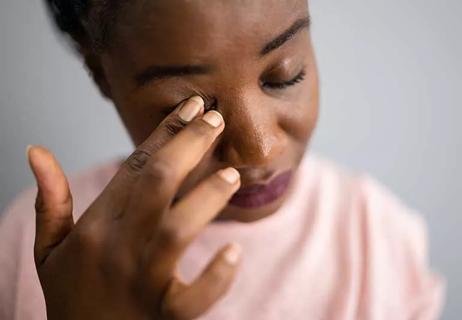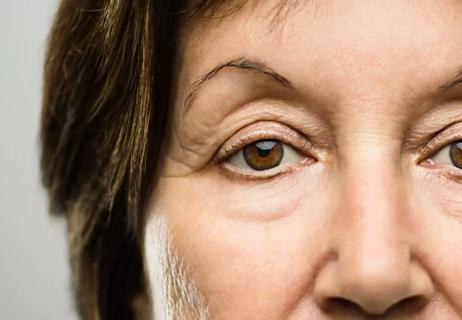Keep your eyes clean and try to stay makeup- and contacts-free to help move healing along

Do you sometimes get tender, red swollen bumps at the edge of your eyelids? They’re probably styes.
Advertisement
Cleveland Clinic is a non-profit academic medical center. Advertising on our site helps support our mission. We do not endorse non-Cleveland Clinic products or services. Policy
A stye is a bacterial infection in an eyelash follicle or tear gland. If you scratch or get bacteria in the area, the follicle or gland sometimes gets blocked and infected.
“Styes typically occur on the outside edge or just under the eyelid,” says family physician Matthew Goldman, MD. “They’re bumps that look like pimples, surrounded by redness. They usually last about three days, pop and then heal in about a week.”
And although they can be painful (and almost always uncomfortable), you can take steps to avoid them.
Dr. Goldman explains how to get rid of a stye at home, and when you need to see a doctor.
If you want to know how to get rid of a stye overnight, it may be best to manage your expectations.
“While an overnight cure is unlikely, you may feel significant relief after starting prompt home care,” says Dr. Goldman. “Most styes can take seven to 10 days to heal with at-home treatments.”
Wondering how to treat a stye? There are a few things you can do at home to help.
“Before touching your eyes or applying any remedies, wash your hands thoroughly with soap and water,” instructs Dr. Goldman.
And then, try one of these home remedies:
You can help the process along by placing a warm, clean, damp cloth on the affected eye for at least 10 to 15 minutes a few times a day.
Advertisement
Folding up a damp washcloth and microwaving it for 10 to 20 seconds can work well. It’s convenient as a warm compress because as any edge of the washcloth gets too cool, you can refold for a warmer side. Just be careful the cloth doesn’t get too hot to use on your eyes.
“The heat allows the stye to drain on its own,” Dr. Goldman explains. “Just continue to reheat the washcloth because it will lose heat over time.”
Over-the-counter ointments, medicated pads and solutions (such as bacitracin eye ointment) may help ease pain, but they don’t necessarily increase recovery time, says Dr. Goldman.
You can also take nonsteroidal anti-inflammatory drugs (NSAIDs) like ibuprofen, which may help reduce inflammation, burning and swelling.
Looking for a tried-and-true, inexpensive option? Dr. Goldman recommends using baby shampoo or another gentle soap that’s free of harsh chemicals, fragrances or dyes.
“Simply wash the eye gently with baby shampoo or a mild natural soap that doesn’t burn your eye,” he advises. “Dilute the shampoo or soap in warm water and apply to your eyelids gently with a clean cotton swab or washcloth.”
To avoid further irritation and infection, Dr. Goldman advises not wearing makeup when you have a stye.
“You want to keep the area clean and uncovered — cosmetics can prevent this,” he says. “Wearing makeup when you have a stye may delay the healing process.”
You also want to clean any makeup brushes and throw away any eye makeup such as eyeshadow, mascara or eyeliner that you may have used when you had a stye.
If you normally wear contact lenses, Dr. Goldman recommends taking a break from them when you have a stye, as they can also cause irritation and infection.
And once your stye is healed, it’s best to start with a fresh pair of contacts to avoid further irritation or infection.
The internet can be full of home remedies — and while some may work, Dr. Goldman says to avoid the following:
Advertisement
If you’re uncertain that what you have is a stye (for instance, it could potentially be a chalazion, a firmer lump in an oil gland in the eyelid that’s less painful than a stye, or fatty deposits known as xanthelasma) or it doesn’t improve within one to two weeks with home remedies, you might need more treatment.
Dr. Goldman recommends checking with a healthcare provider if:
“Styes are generally easily managed and are usually an annoyance rather than a major problem,” Dr. Goldman says. “But if they don’t go away or you have other unusual symptoms, talk to your doctor.”
Advertisement
Learn more about our editorial process.
Advertisement

Many factors, like eyelid irritation, cosmetic lash procedures and underlying health conditions, can affect your eyelashes

Both chalazia and styes appear as bumps on your eyelid — but styes are typically painful

The procedures take different approaches to eliminate saggy, baggy skin around your eyes

Doing so can cause a severe infection, damage to your eyelid or even a corneal abrasion

Injections or surgeries can give aging eyes a lift

This glaucoma drug can also thicken lashes, just note side effects

Pink eye usually refers to infectious conjunctivitis, which can look similar to allergies or other infections and eye conditions

Nocturnal lagophthalmos may be caused by damaged nerves or muscles in your face

The best parenting style balances enforcing rules and showing plenty of love

Tips include cutting back on sugar, focusing on exercise and managing stress

It can be harder to let go when you’ve invested time, energy and emotions — but it might be the healthier choice long term